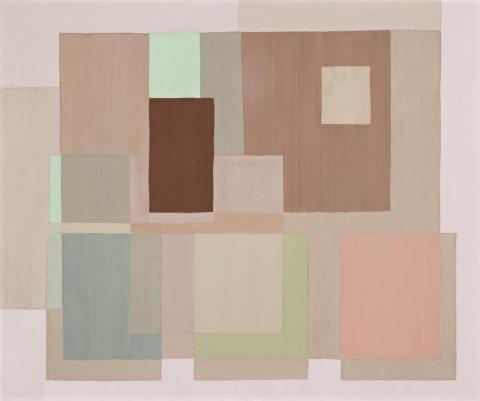CONSTRUCTIVE PAINTING, c.1940-45
RALPH BALSON
oil on board
63.0 x 75.5 cm
Certificate of authenticity from Gallery A attached verso
Estate of the artist
Mrs Winifred Ellis (nee Balson), the artist's daughter
Thence by descent, private collection, New South Wales
Abstract art is all about seeing what you see, requiring no narrative or outside reference for its understanding and enjoyment. Hence the derivation of the oft repeated titles in Ralph Balson's paintings - 'Constructive Painting' - for they are made or constructed out of paint and are complete within themselves. Assured and discreet in their authority, no personal histrionics invade the art of this master, for they are almost anonymous - as if created out of themselves. Balson is one of Australia's finest pioneer abstract painters. From the semi-figurative, as in Portrait of Grace Crowley, 1939, in the collection of the Art Gallery of New South Wales, he moved to the geometric abstractions of this painting until, in his later years, of retirement, his style became freer, embracing painterly abstraction and matter painting in the leisure of painting full time.
History acknowledges the significance of his contribution, participating with Grace Crowley, Rah Fizelle and Frank Hinder in Exhibition I, the 1939 exhibition of semi-abstract works, which unnerved the ultra-conservatism of the time. His solo show of 1941 at Sydney's Anthony Hordern Gallery was the first exhibition in Australia of entirely abstract paintings. It was followed by the Constructive Paintings exhibition with Grace Crowley, Frank Hinder and Gerald Ryan at the Macquarie Galleries, Sydney in 1944. While a complete list of honours attained is unnecessary, mention must be made that in 1961 he received the official imprimatur of being selected for the London Whitechapel Gallery's exhibition Recent Australian Painting, the year after his solo show in Paris.
Constructive Painting, c.1940-45, belongs to that period of his work which reflects the influence of Piet Mondrian in its harmony of geometric forms and avoidance of the subjective in explorations of concepts of the universe. It features the characteristic pastel colours of his palette, the paint applied with thought and method. Forms and colours are beautifully understated in this sonata on a square and rectangle. Commenting on these paintings, Herbert Badham wrote: 'He feels he is on the way to a new expression of reality apposite to modern conditions through constructed relationships of colour and shape.... He believes, too, that the source of true design is to be found in cosmic laws and that this truth offers a better basis for progress than any other.'1 Balson observed: 'As one grows older one contemplates more and more, and maybe the ultimate goal of all the arts is the ineffable.'2
1. Badham, H., A Study of Australian Art, Sydney 1949, quoted in Daniel Thomas,'Ralph Balson', Art and Australia, vol.2, no.4, March 1965, p.257
2. Pacific Loan Exhibition catalogue, cited ibid, p.258
DAVID THOMAS
